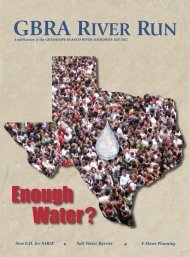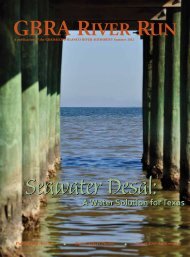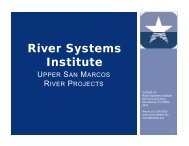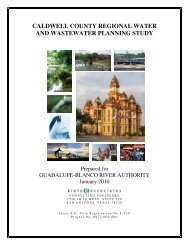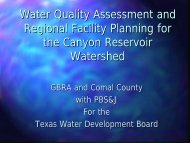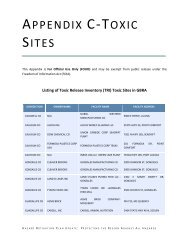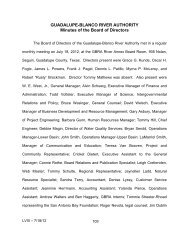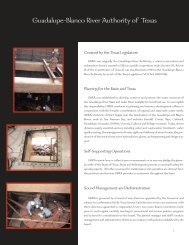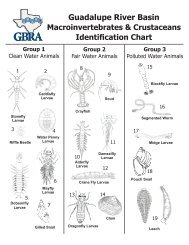Staying Safe Flood Guide - Guadalupe-Blanco River Authority
Staying Safe Flood Guide - Guadalupe-Blanco River Authority
Staying Safe Flood Guide - Guadalupe-Blanco River Authority
You also want an ePaper? Increase the reach of your titles
YUMPU automatically turns print PDFs into web optimized ePapers that Google loves.
The main responsibility for establishing floodplain management rests with local governments<br />
that have the power to direct how certain land will be used and developed within<br />
their boundaries. In many jurisdictions, a <strong>Flood</strong>plain Administrator issues permits and<br />
makes sure that the programs and policies are enforced. In addition, federal and state<br />
governments and river authorities can provide financial and technical help in order to<br />
carry out floodplain management programs.<br />
What elements are used to determine the floodplain<br />
Your local regulatory authority must first determine what kind of resources it has<br />
available to protect its citizens, including finances, manpower, equipment and other considerations.<br />
It then establishes a regulatory floodplain based on the size of the flood and<br />
total area it can reasonably expect to manage.<br />
What does the term 100-year flood mean<br />
It does not mean that your area will flood only once every one hundred years. Rather,<br />
it is a reflection of the magnitude of a flood - one so big that it has a one percent chance<br />
of happening in any given year. A person could live their entire life and never experience a<br />
100-year flood. Or, they could be unfortunate enough to experience several 100-year<br />
floods in one year or just a few years apart.<br />
You are an important part of floodplain management!<br />
If you do not want to be flooded, do not build or live in a floodplain. In addition to<br />
protecting your family and property, this responsible action will help make your local<br />
floodplain management program more successful. As many residents of the <strong>Guadalupe</strong><br />
<strong>River</strong> Basin discovered, the flood of October 1998 damaged areas that had never flooded<br />
in recent history. Some people refused to evacuate homes located above the 100-year<br />
floodplain only to flee hours later as water rushed in. The lesson here is that the 100-year<br />
floodplain is just a guideline. Living above it does not guarantee safety. The 1998 flood is<br />
being called the "500-year flood" by some because of its tremendous size - but it could<br />
occur again in the near future.<br />
How can losses in a floodplain be reduced<br />
Obviously, the less building that takes place in this area the better. However, in existing<br />
floodplains with high occupancy rates, the following methods can minimize damage:<br />
First, structural methods such as flood control dams, levees, diversion channels, tunnels<br />
and other water control measures help to divert and control floodwaters. Other<br />
structural measures include floodproofing of buildings.<br />
Second, non-structural options including requirements for minimum building elevations,<br />
public education, flood insurance and relocation of structures that have previously<br />
flooded, may also reduce losses.<br />
6





